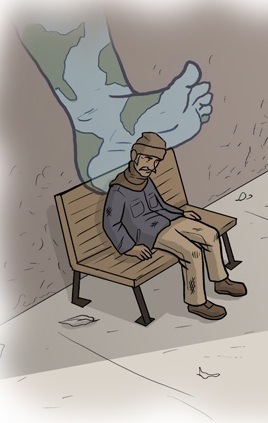Beyond what’s already been said about Ani Difranco’s reaction to finding out that a former plantation was the planned locale for her company’s retreat, I think there’s something to discern from it about so called “hipsters” — a quality of which seems to be priding one’s self as being enlightened when it comes to issues surrounding race and class, though one’s background frequently leads to a life separate from the majority of those who have historically lacked much in the way of privilege.
Criticism about hipsters is, of course, rife throughout all of blogdom — but it’s often frivolous stuff about the way they dress (I would not include the wearing of clothes that mock someone else’s culture in this arena). Also, people seem to pick up on a self-righteousness that comes with defining one’s self as thoroughly counter-culture while being obsessed with culture-as-a-lifestyle. But most of the people doing the criticizing — and certainly the ones whose criticisms are on the noteworthy venues that, inherently, cater to the at least somewhat privileged — are perhaps finding fault with those trying to live a romanticized version of their own upwardly mobile lives. In short, they’re a scapegoat for people who don’t know how to come to terms with the fact that they systematically have more stock than others.
These others are people that hipsters and the upwardly mobile can’t generally seem to connect with — sure, they can do so with people of color whom are associated with the coolness that acts as cultural currency among hipsters, and also occasionally people of color whom they can be self-righteous about (an idea of) equality with. With the upwardly mobile more generally, they seem to connect more easily with people of color who’d prefer to disassociate with that color — with with what can make you less than not so old-fashioned notions of what a normal guy or gal looks like. So there you have a fine melting pot, just not with anyone who really challenges people’s notions of themselves in hierarchies.
Away from that, there’s criticism about hipster re-emergence into the urban world where they frequently define areas in the cultural zeitgeist that had been defined as being “bad (but culturally rich) neighborhoods.” You know — all of those cities, with all of their scary people of color; these were the places fine upstanding people didn’t have to live — not when there’s a perfectly good suburb you can drive comfortably to.
Difranco wrote a song about an element of this. It’s called “Subdivision,” and it starts with the line, “White people are so scared of black people . . .” It’s a good song, and much more in the vein of Bob Dylan’s song about Rubin “Hurricane” Carter than “Ebony and Ivory.” I learned from a documentary that Dylan’s song is one that the great Sam Cooke respected on one level, but on another Cooke seemed to lament that someone who hadn’t experienced racism firsthand hadn’t come out with that song first. I empathize with the feeling because the simple politics of the music business — certainly even more so during Cooke’s heyday — was such that a black artist couldn’t speak his or her truth forthrightly.
Difranco’s initial response to finding out about the plantation as a setting for a retreat noted that she didn’t pick it as a venue, but, once she she knew, it seems she thought it could be an opportunity for healing. I have a lot of respect for Difranco as a writer and musician, but I could never listen to her sing about race at length without feeling like it was nice enough — and not hollow, but just on some other planet where people leave their suburbs, or mini-suburbs, to go on things like retreats.
You see, frequently hipsters may live in urban areas, but they’re areas that have been turned into mini-suburbs that cater to them — this is the general downside of a place becoming what we generally think of as being livable. You can live in a place that’s associated with being some great urban place where people of color managed to get by in hard times, but really it’s separate from the heart of that — the part that knows about what the pain of being in the “less than” part of town added up to.
I’m not someone who thinks Difranco should be demonized (there’s a component of her detractors who salivate over this sort of thing and have no personal regard for black pain otherwise), but it’s worth noting that maybe knowing about subdivisions doesn’t make one as aware of the pain of being “less than” as some people might like to think.

